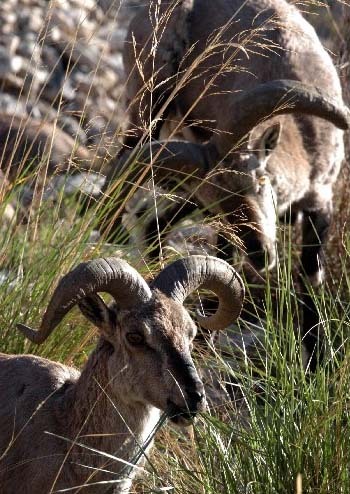Chinese conservationists have been fumbling hard for ways to rein in an overpopulation of blue sheep.
The blue sheep is an endangered wild species of sheep mainly living in Mount Helan, at the meeting of the Ningxia Hui and the Inner Mongolia autonomous regions.

Blue sheep living in Mount Helan, Ningxia Hui Autonomous Region (file photo).
Before 1983, the blue sheep was hunted, causing the animal's population to fall sharply to the endangered level.
Central and local governments started protecting the animal in 1988, when Mount Helan Nature Reserve, covering an area of 153,333 hectares, came into being.
The blue sheep numbers have been increasing rapidly over the past decades at the reserve, with the number of the animal rising from fewer than 1,800 in 1983 to 15,000 at present.
They have almost no natural enemies, according to Hu Tianhua, chief of the scientific research and publicity of the Mount Helan Nature Reserve Administration.
Wolves and other large carnivores used to live in the area, but disappeared decades ago because of hunting and development, said Hu.
Up to now, the blue sheep population has reached 19 per square kilometre, higher than the limit of 17.6 head on each sq km of land, partly because of the animal's ability to reproduce quickly.
Sun Guoliang, chief of forest conservation section on the reserve, noticed a decline in the animals in the wake of the rise in the blue sheep population.
"In the past, blue sheep were much larger, and they ran very fast and vigorously, but nowadays, the animals grow smaller and smaller," said Sun, "there is also a growing tendency that the blue sheep's adaptability toward an adverse environment has been on the decline."
A sharp increase in the sheep's population has also harmed the ecological balance of the nature reserve they inhabit, according to Ba Qingsheng, deputy chief of the forest resource section of Ningxia Hui Autonomous Regional Bureau of Forestry.
"Overpopulation of the blue sheep has made it hard for the vegetation around Mount Helan to remain," said Bai, "the blue sheep has strong reproductive capabilities and good appetites as well: they eat not only grass, but also shrub leaves, which has in turn done great damage to the vegetation."
The quick rise in the number of blue sheep has led to the decline in the number of other herbivorous animal species too, reckoned Hu.
Elks, a deer species that feed on grasses, plants, leaves and bark and also have high level of adaptability, for instance, have been on the wane around Mount Helan because of limited food resources caused by over-population of blue sheep.
Mount Helan Nature Reserve Administration has been cooperating with a couple of organizations in hope of finding countermeasures to curb the over-population of the blue sheep family since November 1998.
Researchers from organizations such as the Shaanxi Provincial Institute of Zoology have put forward a host of suggestions, ranging from the introduction of wolves, migration of the blue sheep, the granting of hunting quotas, to domestication.
Apart from domestication, the rest of the suggestions have never been carried out in reality because of concerns about possible adverse effects cropping up following those suggestions, according to Bai.
Bai cited dropping of the idea to reintroduce wolves at Mount Helan as an example.
The suggestion never materialized because some local officials and experts worried that introducing wolves may cause the number of sheep to decrease too sharply.
(Xinhua News Agency April 3, 2008)